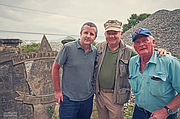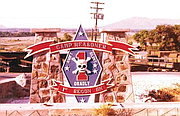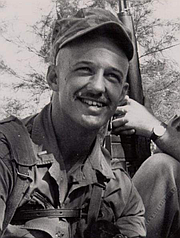After all these years
By CHANSE WATSON
Managing Editor
Most Silver Valley natives are familiar with the heroic actions of United States Marine Corps First Lt. Frank S. Reasoner of Kellogg. For those who are unfamiliar, Reasoner was posthumously awarded the Congressional Medal of Honor for his heroic actions (that ultimately led to his death) during the Vietnam War.
His deeds and his memory have been memorialized by servicemen and civilians in many different forms.
Locally, the Frank Reasoner memorial in the middle of Kellogg honors his sacrifice. Nationally, Reasoner is featured on the Marine Corps 3rd Reconnaissance Medal of Honor monument in Ocala, Fla., and was the namesake of the now-decommissioned Navy frigate, USS Reasoner.
Possibly the least well-known memorial to Reasoner of them all though is the one that remains in Vietnam, the one that identifies the location of the former 1st Reconnaissance Battalion base camp, and the one that has miraculously stood the test of time and man.
Born on Sept. 16, 1937, in Spokane, Wash., Reasoner and his family moved to Kellogg in 1948, where he would graduate from Kellogg High School in 1955.
Shortly before his 18th birthday, he enlisted in the U.S. Marine Corps. Over the next 20 years, Reasoner would rise through the ranks and was eventually promoted to First Lieutenant in 1963 following his graduation from the U.S. Military Academy (West Point) and Officers Basic School.
Assigned to the 3rd Reconnaissance Battalion, Reasoner would get sent to Vietnam in April 1965 following a three-year deployment in the Pacific.
Once there, he was made Commanding Officer of Company A, 3rd Reconnaissance Battalion, 3rd Marine Division.
On July 12, 1965, Reasoner was leading a small patrol in the Quang Nam province when a company of Viet Cong soldiers ambushed them. During the course of the fighting, Reasoner put himself in harm’s way multiple times to protect his men and killed at least two enemy combatants in the process before he was hit by enemy machine gun fire while attempting to aid his wounded radio operator.
He was killed instantly as a result.
To recognize his sacrifice, the Marines of the Reconnaissance Battalion named their base camp at Hill 327 near Da Nang, “Camp Reasoner.” To make it official, a stone sign was installed in 1969 near the gates of the camp that depicted the name with the battalion’s logo and title.
With an official ceasefire declared in 1973, U.S. military forces evacuated Vietnam with only the essentials and a giant stone sign affixed to the ground certainly did not qualify.
Roughly 50 years later, the memory of First Lt. Reasoner certainly lives on, but the camp sign with his name was largely forgotten about and/or presumed destroyed by the Vietnamese — until now.
Ret. Marine Corps Sgt. Steve Berntson, who was born in Clark Fork and raised in Hope, took a trip to Vietnam in March with 10 other Marines and one Navy Corpsman to visit old battle sites.
“In my particular case, I was a combat correspondent/photographer for the Marines and I was with 1st Marine Division,” Berntson said. “I was asked to participate in this trip because I had some knowledge of the Battle of Hue City.”
Berntson severed in Vietnam from 1967 to 1968.
Made possible by the The Greatest Generations Foundation, the trip had the men visiting several different locations they served at during the war.
“Some of the battlefields can’t be reached because of the jungle and everything else,” Berntson explained, “but it was still a marvelous opportunity to go back to where many of us had fought…and had experiences in that particular war.”
One of the biggest (if not the biggest) highlights of the trip for Berntson occurred early on in their 10-day trek across Vietnam at the site of a certain old Marine Corps base.
“One of the first days, we went out to where we had been the 1st Marine Division Headquarters outside of De Nang,” he said. “It was a huge area because it was a division headquarters that had many different units attached to it … so there used to be dozens and dozens of small huts and buildings and trailers that designated it as a combat base.”
As they followed a ridge line to get as close as they could to the former base, they discovered that the area had been completely turned into a rock crushing and gravel compound with heavy equipment.
“As we were driving up the road, there was nothing. You could hardly identify anything of what once had been that big base.”
It wasn’t until they reached the top of the hill that they discovered “something that shouldn’t have been there.”
“All of a sudden somebody says ‘hey! Look at that!’ There was the arch that had been made to designate the gate to the 3rd Marine Division Recon, named after Frank.”
The discovery of the almost 50-year-old sign was quite the surprise for the group, considering that other landmarks such as this (including other base signs) had not fared as well.
“There’s nothing,” Berntson said of the remaining infrastructures. “Over the last 50 years, the Vietnamese government has made sure that any and all kinds of memorials to either South Vietnamese, or to Americans, has been torn down or destroyed. They didn’t want any reminders of it.”
Nestled right next to the rock crushing compound, the sign also is under constant threat of being crashed into by work vehicles.
Curious as to why this particular sign remains while so many others have been destroyed, the group consulted the locals.
“One of the Vietnamese suggested one of the reasons it could be there is that the Vietnamese are very much aware of spiritual things,” Berntson said. “And they thought maybe, for one reason or another, that there was a spirit around so nobody has ever tried to destroy it or deface.”
Regardless of the reasoning, Berntson and the rest of the group were overcome with joy and surprise upon discovering the sign.
“There was nothing left of that huge Marine base there except for that one arch,” he said. “It’s amazing to be there, we couldn’t believe it because there’s nothing else.”
What made this discovery even more special to Berntson was the fact that he actually had ties to Frank Reasoner through his wife, Beverly.
“He (Reasoner) grew up in Kellogg and one of his school friends, and after school, was my wife’s first husband who passed away.”
Her late husband was Kellogg native Logan L. Durbin Jr.
“He was a year older than Frank, but they ran around together when they were young,” Berntson said.
Beverly and her late husband were even invited by the family of Frank Reasoner to the christening of the USS Reasoner in 1970 in Seattle.
Now back home with new photos and memories, Berntson stresses that the entire trip could not have been possible if it were not for the efforts of The Greatest Generations Foundation.
Founded in 2004 by Australian native Timothy Davis, TGGF initially started out by taking World War II veterans to old battle sites in Europe. As time went on though, fewer and fewer World War II vets could make the trip, so it was decided to get groups of Vietnam veterans together and do the same thing.
First Lt. Frank S. Reasoner is buried in Greenwood Cemetery in Kellogg.
His Medal of Honor Citation reads:
“His indomitable fighting spirit, valiant leadership and unflinching devotion to duty provided the inspiration that was to enable the patrol to complete its mission without further casualties. In the face of almost certain death, he gallantly gave his life in the service of his county. His actions upheld the highest traditions of the Marine Corps and the United States Naval Service.”







